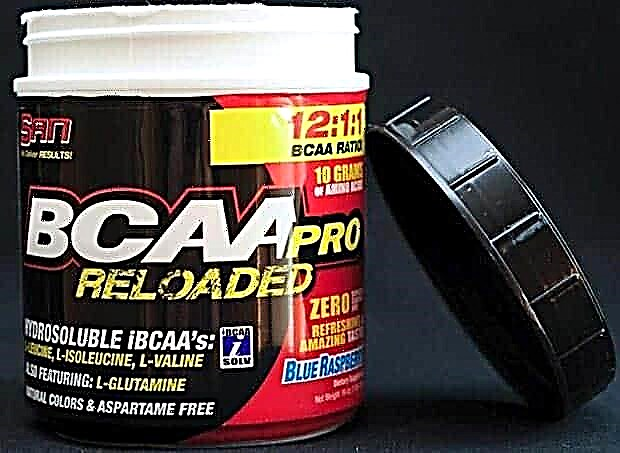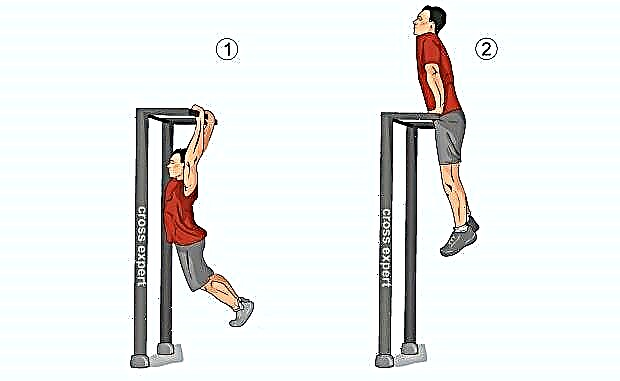A healthy lifestyle has become a real trend in recent years. Its integral part is the most "fat-free" body with beautifully contoured pumped up muscles. This can be achieved only by a combination of competent training and proper nutrition.
There is a lot of information about special diets for drying and losing weight on our website. But today we will consider in detail one of the options for "fat burning" training. This is an interval training session for burning fat. What this technique is and how to practice it, read below.
How training works
Why is the word "fat burning" in quotation marks? For the simple reason that interval training for weight loss, like any other training, can be called fat burning only conditionally.
Strength training, even if it is “for relief”, does not burn fat by itself. The essence of interval training is also somewhat different - the main thing here will be the acceleration of metabolic processes, which will increase the consumption of calories throughout the day. Direct fat burning is possible under some conditions during low-intensity long-term cardio, but the process of losing weight will still depend on the diet, because if you eat sweets all day after training, you will only gain weight.
So remember - workouts alone are not enough to lose weight, even if they are super effective. You also need to monitor your diet.
Creating a calorie deficit
Let's take a look at some basic principles of getting rid of excess subcutaneous fat.
In order to lose weight, in addition to intense training, you need to create a calorie deficit. Simply put, you need to consume fewer calories than you spend during the day. Without this condition, all further conversation is meaningless. The deficit should be no more than 20% of the norm. If you consume less, the effect will be the opposite.
It would seem, what does training have to do with it? You can simply eat less, maintain a deficit and lose weight. But let's go through all the principles in stages.
So, the first thing to lose weight is to create a calorie deficit. But it is worth remembering that our body receives the missing energy from two sources: from our fat reserves and from our muscles. If we do not actively use muscles, that is, we train, then it is the muscle mass that will be primarily used to cover energy needs.
Also, as already mentioned, interval training accelerates the metabolism, which leads to an increased consumption of calories by the body. Your rate can grow, for example, from 1600 to 1800-1900 kcal per day, which will allow you to eat more and not starve yourself. And training itself requires certain energy costs.
That is why - a positive effect on metabolism and calorie expenditure, as well as preserving muscles while losing weight - in addition to a proper diet, we also need training.

© gearstd - stock.adobe.com
Androgen training
Fat burning is regulated by stress hormones such as adrenaline and norepinephrine. But the influence of other hormones is also important. For example, cortisol can break down muscles and, conversely, promote fat storage.
Growth hormone and testosterone during weight loss act in such a way that muscle mass is not catabolized. This means that we must make sure that they predominate in our hormonal background. Exogenous administration of drugs is not the best idea for an amateur; it is better to leave it to professional athletes. And that's why amateurs need training. It is in response to training that the human body releases the androgens and growth hormone that we need so much. Research shows that interval training shows marked increases in testosterone levels.
The essence of weight loss workout
There are many training protocols for “fat burning”. Interval training is optimal for this purpose. What is its essence? At least two exercises are chosen: one of them is performed in an explosive manner, with maximum speed and intensity for a short period of time (10-120 sec). Beginners should start with a minimum of 10-15 seconds of high intensity.
The second is performed without rest after the first exercise, but in an aerobic style - at a low pace with medium or low intensity. The second exercise is used as a kind of rest period and should last longer than the first period. For a beginner - 3-5 times. Experienced athletes can achieve equal periods of high and low intensity.
Actually, training consists of alternating "explosive" periods and periods of "rest". There can be 5-15 such cycles in total without rest between them. The total workout time is 10-30 minutes.
Examples of the high-intensity portion are: running at maximum or near-maximum speed, jumping rope at a high pace, brisk cycling, and in the case of strength training, doing exercises with maximum intensity. Low-intensity part: jogging, walking, slow riding on a stationary bike, and in the case of strength - just relaxation, during which you can walk around the hall, restoring your heart rate.
By the way, about the pulse. Interval training is best done with a heart rate monitor. The high-intensity pulse should be between 80-95% of maximum. But at the same time, you cannot carry out all this part with a heart rate of 95% - it is better to reduce the load. 95% is the upper limit, which can only sometimes be reached. For beginners, 80-85% is enough. The low-intensity part runs in the range of 40-60% of the maximum.
Types of fat burning workouts
Most often, fat burning interval training is understood as interval cardio. Running, jumping rope, jumping in place, swimming, exercise bike, bicycle, ellipsoid, rowing machine, etc. are all great for successful weight loss. Do not forget only that interval training includes 2 types of loads - heavy and light. It is also worth adding a few classic strength training so that the muscles do not "crumble" in a calorie deficit. This is especially important for those who already have decent muscle mass. For beginners, it is permissible to simply use interval cardio for weight loss, and then gain weight with the help of classic workouts.
Strength interval training is used less often, most often by girls and beginners - they are most suitable for them. Or with the periodization of loads in experienced athletes.
Next, let's look at the main types of interval training for weight loss.
Interval running workout
The simplest "interval" option you can do in a stadium is what is called an interval fat-burning running session. You warm up, do a slight stretch of the ligamentous-tendon apparatus. After that, run a certain distance, alternating 10-30 second accelerations with intervals of measured running. With this option, it is important to remember that the quiet running time should not be excessively long - no more than 2-3 minutes. It all depends on your level of training.
If you have nothing to keep track of the time, there is an easy way out - do the intervals according to the distance. For example, you have a classic 400-meter stadium. You need to run a straight section (about 100 m) at the maximum, and then walk both turns and the second straight section, restoring your breath. Over time, you can increase your fast run intervals.
If there is no stadium near the house or you do not like to run in open areas, then this is not a problem either. The same running workout can be done in the gym on a treadmill. It is enough to simply adjust its speed and ascent angle at intervals.

© Drobot Dean - stock.adobe.com
Interval workout workout
Workout practitioners can be advised to alternate "explosive" pull-ups and / or push-ups with measured squats.
It can look like this: in 10-20 seconds, the maximum number of pull-ups with cotton is done, jumping off the bar, the athlete switches to squats without weight, performing them measuredly, slowly for 30-60 seconds. After the last squat, a lying emphasis is taken and the maximum number of push-ups is performed in 10-20 seconds. Next come squats again, followed by pull-ups. And so 5-10 cycles. A static exercise such as a plank is also suitable as a "rest" period.
An excellent option for boxers would be to alternate the most intense jumping rope with periods of measured jumps for at least 10 minutes.

© Nadezhda - stock.adobe.com
Tabata Protocol
The interval training program for weight loss can also be based on the so-called "Tabata protocol". It is named after the author - the Japanese scientist Izumi Tabata.
The system was originally used to train skaters. This is a kind of extremely intense workout. Its meaning is to alternate exercises at a high pace for 20 seconds (for which you need to complete about 30 repetitions) with a 10-second rest interval. After rest, intensive work takes place again, then rest - and so on. And so on for 4 minutes. This is followed by a short rest and a new segment of 4 minutes.
You can do the same movement, you can alternate 2 or more exercises, you can do a new one each time. For beginners, bodyweight exercises are suitable - burpees, push-ups, squats, jump squats, pull-ups, parallel bars. Experienced athletes can choose exercises with additional weights. The selection conditions are simple: the use of a large muscle group and the ability to perform the exercise at high speed.
Exercise with cardiovascular equipment
If you are used to working out only in the gym, use the machines available there, such as a bicycle and an ellipsoid, for interval cardio training.
Interval training with the elliptical weight loss machine is very effective. An example of such a workout: 5 minutes of warm-up, reaching 50-60% of the load from the maximum heart rate. Then alternate 2 minutes of work 50-60% of the maximum and 1 minute of work 80-85%. Work for 20-30 minutes, and at the end do a 5-minute cool down at a fairly slow pace.
Tips for organizing training
To get the maximum effect from interval training (in terms of fat burning), you must adhere to the following rules for organizing the training process:
- It is helpful to take a serving of BCAAs immediately before and after training.
- Before moving on to the main part - directly the intervals - you need to thoroughly warm up, perform a joint warm-up of the whole body and 1-2 sets of those exercises from which you plan to build your training. Naturally, at a measured pace and with light weight.
- Cool down for 5-10 minutes after training. You can supplement it with a stretch.
- If you are using interval running, replace your standard low-intensity cardio with it. At the same time, train also with a strength orientation (naturally, on days when you are not running). The overall effect of this approach in fat loss will be more significant.

© baranq - stock.adobe.com
Home Interval Workout Programs
We have already written above about how to properly organize running interval training. Now let's figure out how you can train without leaving your home and without using any additional equipment.
Home Interval Workout:
| Exercise name | Task, time / number of repetitions |
| Easy running in place | Warm up - 5 minutes |
| Jump squats | 20 seconds for maximum amount, perform intensively |
| Leisurely walking | 40 seconds, we restore the pulse |
| Easy running in place | Cool down - 5 minutes |
It is necessary to do 15-20 cycles of squatting and walking. You can also alternate exercises. For example, with 3 times a week, you do squats on the first day, wide-arm push-ups on the second day, and burpees on the third.
Interval Gym Program
While in the gym, it would be foolish not to use the main weapon in the fight for quality musculature - the barbell and dumbbells. It is free weights that can create the maximum load on the muscles.
An interval gym session might look like this:
| Exercise name | Task, time / number of repetitions |
| Exercise bike | Warm up - 5 minutes |
| Barbell Trasters | 20-40 seconds as intensely as possible, 3 sets, 40-60 seconds rest between sets, during which we slowly walk around the hall |
| Dumbbell bench press | 20-40 seconds, 3 sets, 40-60 seconds rest between sets |
| Bent-over barbell row | 20-40 seconds, 3 sets, rest 40-60 seconds between sets |
| Barbell Front Squat | 20-40 seconds, 3 sets, rest 40-60 seconds between sets |
| Treadmill, walking | Cool down - 5 minutes |
Attention: This program is not designed for a beginner, experience in strength training and skills in correct technique is required.
The moment with breathing is extremely important: throughout the entire program, you cannot hold your breath and strain. You breathe in at the moment of relaxation, exhale with effort.
Strength and aerobic exercise program
The optimal combination of cardio and strength interval training in a gym might look like this:
| Exercise name | Task and number of repetitions |
| The first day. Power | |
| Treadmill | Warm up - 5 minutes |
| Swing the kettlebell with both hands | 20-40 seconds as intense as possible, 5 sets, rest 40-60 seconds between sets |
| Barbell Front Squat | 20-40 seconds, 5 sets, rest 40-60 seconds between sets |
| Ellipsoid | Cool down - 5 minutes |
| Second day. Cardio | |
| Treadmill | Warm up - 5 minutes |
| Treadmill, fast running | 15 seconds |
| Treadmill, walking | 45 seconds, total 15 cycles per minute |
| Treadmill | Cool down - 5 minutes |
| Day three. Power | |
| Ellipsoid | Warm up - 5 minutes |
| Dips on the uneven bars | 20-40 seconds, 5 sets, rest 40-60 seconds between sets |
| Taking a barbell on the chest in gray | 20-40 seconds, 5 sets, rest 40-60 seconds between sets |
| Ellipsoid | Cool down - 5 minutes |
| Day four. Cardio | |
| Exercise bike | Warm up - 5 minutes |
| Exercise bike, maximum pace | 15 seconds |
| Exercise bike, easy pace | 45 seconds, total 15 cycles per minute |
| Exercise bike | Cool down - 5 minutes |
Whatever type of interval training you choose, if you follow the regimen and diet, it will definitely bring you a positive result in burning subcutaneous fat.









